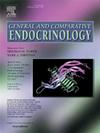雄性斑胸草雀筑巢和循环睾酮动力学。
IF 1.7
3区 医学
Q3 ENDOCRINOLOGY & METABOLISM
引用次数: 0
摘要
尽管对鸟类繁殖具有重要意义,但支持筑巢的激素机制仍然知之甚少。虽然雄性和雌性的筑巢者都需要循环使用性类固醇,但尚不清楚这些类固醇是否在整个建造过程中都需要。因此,我们试图确定雄性斑胸草雀在繁殖早期的循环睾酮动态,特别关注筑巢期。我们在以下四个时间点中的三个时间点采集了两组鸟类的血浆样本:筑巢前(基线)、配对后、筑巢期间和筑巢后。为了将筑巢结束与孵化开始分离开来,我们每天都要移除所有产下的蛋,并在筑巢期间采集到雄性样本后终止筑巢。雄性的循环睾酮水平在与雌性配对后和整个筑巢过程中保持稳定。然而,一旦筑巢停止,睾酮滴度就会下降。我们还发现有证据表明,与雌性配对后,循环睾酮滴度可以预测雄性未来的生育准备。总之,我们的数据表明,循环睾酮在整个筑巢过程中很重要,直到筑巢活动结束才会减少,这可能是通过一种“自我反馈”机制。本文章由计算机程序翻译,如有差异,请以英文原文为准。

Nest building and circulating testosterone dynamics in male zebra finches, Taeniopygia guttata
Despite its fundamental importance for avian reproduction, the hormonal mechanisms supporting nest building remain poorly understood. While nest building by both male and female builders requires circulating sex steroids, it is not clear whether these steroids are required throughout building. We, therefore, sought to determine circulating testosterone dynamics in male zebra finches during early breeding, specifically focusing on the nest building period. We collected plasma samples from two cohorts of birds at three of the following four timepoints: before (baseline), following pairing, during, and after nest building. To dissociate the end of nest building from incubation onset we daily removed any eggs laid and terminated nest building once we had sampled males during nest building. Male circulating testosterone levels remained stable following pairing with a female and throughout nest building. However, testosterone titers dropped once nest building had stopped. We also found evidence to suggest that, following pairing with a female, circulating testosterone titers can predict a male’s future readiness to build. Together, our data suggest that circulating testosterone is important throughout nest building, not decreasing until the end of nest building activities, perhaps through a ‘self-feedback’ mechanism.
求助全文
通过发布文献求助,成功后即可免费获取论文全文。
去求助
来源期刊

General and comparative endocrinology
医学-内分泌学与代谢
CiteScore
5.60
自引率
7.40%
发文量
120
审稿时长
2 months
期刊介绍:
General and Comparative Endocrinology publishes articles concerned with the many complexities of vertebrate and invertebrate endocrine systems at the sub-molecular, molecular, cellular and organismal levels of analysis.
 求助内容:
求助内容: 应助结果提醒方式:
应助结果提醒方式:


